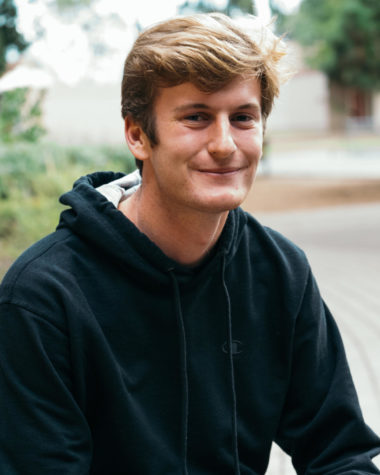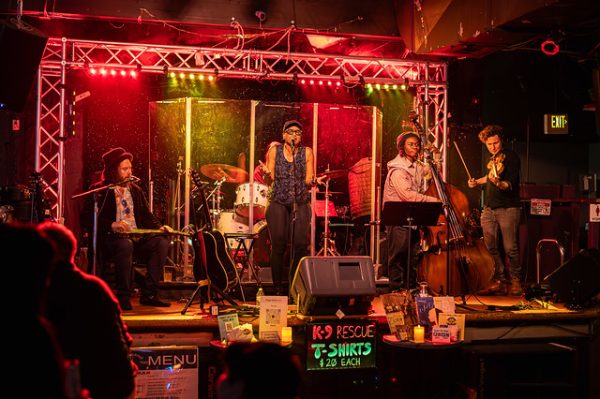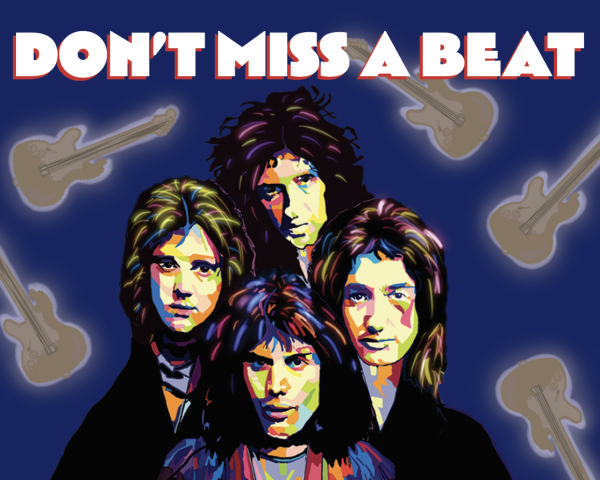Paly to Platinum
C magazine delves into the history of Paly band culture, and how certain artists were able to continue their careers after graduation.
Prior to the late 2000s, band culture played a large role in Palo Alto, especially at Palo Alto High School. The music scene was integrated throughout the city and influenced high schoolers to form bands and pursue their musical ambitions,. While many of these bands were formed for fun among friends, some of them rose to fame, leading to a full-time career in music. From playing gigs in garages to playing sold out shows across the country, the Palo Alto band culture was a big part of people’s daily life. C Magazine takes a look at what this exciting experience was really like and how the band culture in the area has morphed since then.
Ugly Kid Joe
A prominent band during this cultural era was Ugly Kid Joe, a group whose sound ranges from rock to heavy metal. It was formed by two longtime friends, Whitfield Crane and Klaus Eichstadt, both Paly graduates. The band released four full-length studio albums, two of which went certified double platinum, along with two compilation albums and two EPs.
Before all of their success, Crane and Eichstadt were two Paly students with a dream of pursuing music as a career.
“When I was 14, Klaus and myself went to learn guitar from this guy in Palo Alto named Ken Brown,” Crane said. “I gave up on guitar immediately because of my attention span… I was kinda jealous of Klaus because he was learning how to play the guitar and was way cooler than I was so I decided that I was gonna be the singer.”
The two spent hours at Crane’s house, blasting Crane’s mom’s speakers while working on their music. Despite their mutual interest in creating a band together, Eichstadt was apprehensive of Crane’s singing abilities.
“I thought that I could be the singer of the band so in the bike racks of Palo Alto High School, I walked up to them [Eichstadt and his friend] all excited because I wanted to be the singer of their band, Jigsaw,” Crane said. “But there was another singer that they thought was cooler than me so I was out.”
Following graduation, Crane moved to Isla Vista, Santa Barbara, where he began to take music seriously.
“I moved to Isla Vista in 1989 with a skateboard and a backpack and I got in a band there called Overdrive,” said Crane. “Klaus still didn’t believe I could sing so I made a demo [with Overdrive] and brought it back to [Eichstadt’s] house in Palo Alto and showed him.”
Impressed, Eichstadt dropped everything and moved to Isla Vista, where he and Crane created Ugly Kid Joe.
Early on, Ugly Kid Joe performed around Santa Barbara, drawing crowds of around 800 people. However, it didn’t take long for the band to get a record deal with Mercury Records, who provided the resources to create their first music video to their song, “Everything About You.”
MTV, a TV station that, at the time, was very known for broadcasting music videos and giving exposure to smaller artists, caught attention of Ugly Kid Joe’s music video for “Everything About You,” and helped the song blow up.
“After that it went boom, boom, boom,” said Crane. “We went from messing around on skateboards and drinking beers in Isla Vista to touring with Ozzy Osbourne and Motorhead within about 4 or 5 months.”
In 1991, Ugly Kid Joe gained worldwide fame. They worked in studios all over California, creating albums such as, “As Ugly as They Wanna Be” (1991) and “America’s Least Wanted” (1992). Along with creating music, they continued to perform with Ozzy Osbourne, Motorhead, Judas Priest, Van Halen and Bon Jovi. The band’s solo tours were immensely popular, selling out stadiums across America.
“We got to do all the things that one hopes to do as a 23 year old kid in a rock band,” Crane said. “It was everything we hoped and prayed for times one million, but it was a lot to deal with.”
Crane described fame as being very serpentine and seductive.
“It is almost like a drug addiction, so we always had to keep an eye on it,” Crane said. “But at that age you don’t really know what it is, and it sends you out of your comfort zone. It is something that a lot of people don’t survive, if you look at the casualties of rock history … it is just how it is. But we survived and it was scary but also beautiful.”
As Ugly Kid Joe gained popularity, they moved from performing in concerts and festivals in the US to performing around the world.
“I had never traveled out of California, nor did I ever think I was gonna travel,” Crane said. “Imagine landing in Australia and having 5-8 thousand people come see you … or walking on stage in a country you have never been in, in a town you have never been in and playing for people who know who you are.”
After immense success, Ugly Kid Joe broke up in 1997; however, both Crane and Eichstadt continued to pursue music. Eichstadt remained an accomplished guitarist while Crane worked on other bands such as Another Animal and Richards/Crane.
Despite the long time apart, the road was not over for Ugly Kid Joe. In 2010, the band reunited and have since continued to tour the world and make new music.
The Donnas:
Brett Anderson, Allison Robertson, Maya Ford and Amy Cesari made their first debut at a lunchtime show in the Jordan Middle School cafeteria, eventually forming the Donnas.
At the age of 12, these girls had already found their own way of expressing themselves: through rock music and various colored tights. Due to their individuality, they received lots of backlash from their peers throughout the beginning of their careers. In high school, Anderson remembers other students not being supportive of their music. “People would leave notes on our lockers saying ‘go home and play with your dolls,’” Anderson said.
Despite their peers’ criticism, the girls did not let anyone hinder their success, reminding themselves that there is a much bigger world outside of high school. In 1992, while they still attended school, the band officially signed to a small indie record label.After signing, their careers took off from there. During their junior year at Paly, they travelled halfway around the world to Japan, where they were greeted by a crowd right as they stepped off the plane. Outside of their small high school, these girls were a smashing success.
Despite the rebellious image the band had built for themselves, they were very studious and dedicated to school. “We have a song called ‘Don’t Wanna Go to School’ but we actually loved school,” Anderson said. “We would trash dressing rooms and clean them up at the end.”
They felt that to portray a certain image, they had to stick to playing a role for the public. Anderson said they put a defiant façade forward when they were truly quite the opposite. In order to be able to follow their dreams at a young age, they had to prove to their parents and teachers that they were responsible enough to do so. “We always got good grades, that was important, your ticket to ride, your parents can’t tell you what to do, I’m kind of checking all the boxes,” Anderson said.
Toward the end of their high school careers, students at Paly began to appreciate their work, but still, even when they were performing in clubs in San Francisco and Los Angeles, Anderson remembers Paly students not truly recognizing their success. “Those clubs were real scenes,” Anderson said. “And then we got to Paly and people would be like, ‘who do you think you are?’”
After high school, the Donnas dropped the smaller label, signing with the acclaimed “Lookout Records,” notable for signing Green Day. The girls only attended college for a semester, leaving to fulfill their dreams of playing music. However, their struggles of criticism and judgement didn’t stop after high school— being one of the first major all-girl bands isolated them. “A dude in a band is going to get laid,” Anderson said. “If you’re a girl, it’s the total opposite; it’s kind of a strange alienation.”
Even though they did not receive the same attention an all-boy band may, they still had quite a large following. “We got to be role models for people who didn’t want to just watch popstars,” Anderson said. She remembers travelling to Brazil and being in awe of the crowd, “It is just such a populated country, our crowd was filled with tough girls,” Anderson said. “It’s just really cool to look out to.”
Being able to reach a crowd who was not as interested in mainstream music in the 90’s was something they were appreciative of. “The support we received was really contagious,” Anderson said. She felt as if them pursuing music was them focusing on the art and following those they admire, so having many people listen and love their music was surreal.

Mahati Subramaniam joined C Magazine because of the variety of content that was present, and the interesting designs. Her favorite part of C mag is production...








